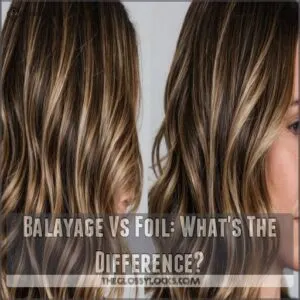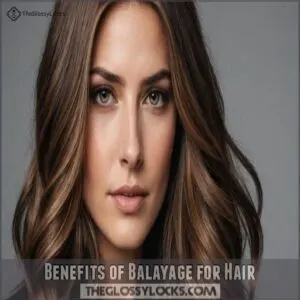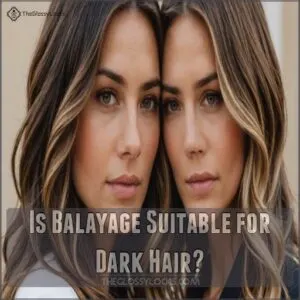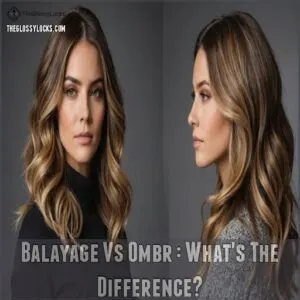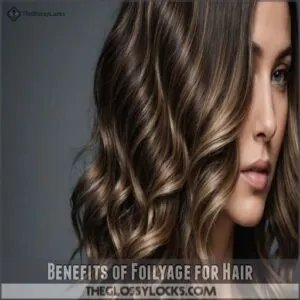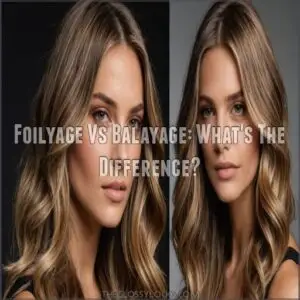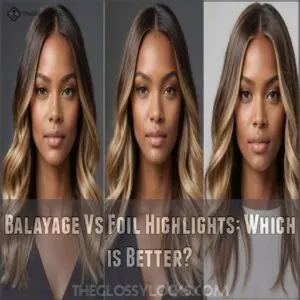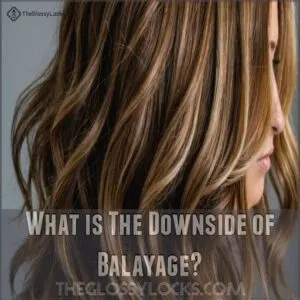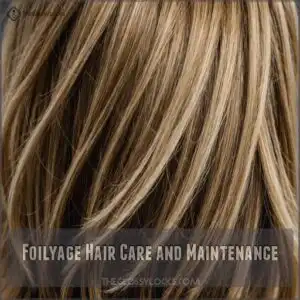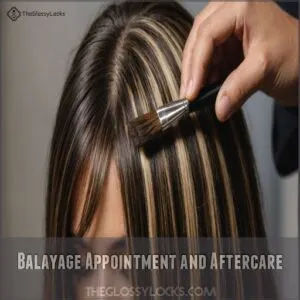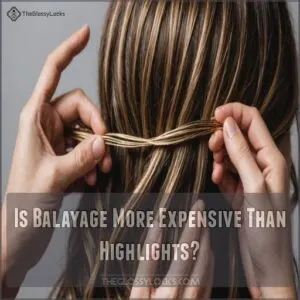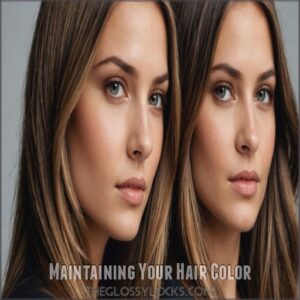This site is supported by our readers. We may earn a commission, at no cost to you, if you purchase through links.

Foil highlights deliver precise, dramatic results with clear sectioning, but you’ll need maintenance every 6-8 weeks. While balayage costs more initially, you’ll visit the salon less often.
Foils work better for dramatic transformations, while balayage creates that "born with it" look. Your lifestyle and desired level of dimension will guide your perfect match.
Table Of Contents
- Key Takeaways
- Balayage Vs Foil: What’s The Difference?
- What is Balayage and How Does It Work?
- What is Foilyage and How Does It Work?
- Balayage Vs Foil Highlights: Which is Better?
- Grow-out
- What is The Downside of Balayage?
- Foilyage Hair Care and Maintenance
- Balayage Appointment and Aftercare
- Can You Combine Balayage and Foil Highlights?
- Is Balayage More Expensive Than Highlights?
- Maintaining Your Hair Color
- Frequently Asked Questions (FAQs)
- Are hair foils better than balayage?
- What is the difference between balayage & foilage?
- What is balayage & foil highlights?
- What is the difference between partial foil and balayage?
- Can you combine balayage and foil highlights?
- Do stylists use balayage & foils?
- What is the downside of balayage?
- What is the main difference between foil lightning and balayage?
- Is balayage a partial or full foil?
- Why is balayage so much more expensive than highlights?
- How does pregnancy affect balayage and foil results?
- Can grey hair be effectively covered with balayage?
- Does swimming affect balayage differently than foil highlights?
- Which technique works better for very fine hair?
- How do seasonal changes impact balayage versus foils?
- Conclusion
Key Takeaways
- You’ll get natural, sun-kissed highlights with balayage that grow out seamlessly and require touch-ups every 3-4 months, while foil highlights create precise, dramatic results but need maintenance every 6-8 weeks.
- To achieve the best results from balayage or foils, consider your hair type and its specific hair type conditioner needs. Your hair type matters – balayage works best on wavy or curly hair, while foils are ideal for straight and fine hair types that need more controlled lightening.
- You’ll spend more initially on balayage ($150-300) compared to foils ($75-200), but you’ll save money long-term since balayage requires fewer salon visits.
- You can combine both techniques using foilyage – it gives you balayage’s natural look with foils’ lifting power, perfect if you want bright highlights while maintaining a seamless grow-out.
Balayage Vs Foil: What’s The Difference?
If you’re trying to choose between balayage and foil highlights, you’ll want to know that balayage involves hand-painting color for a natural, low-maintenance look, while foils create more precise, brighter results that might need more frequent touch-ups.
You’ll find that balayage works best for a subtle, sun-kissed effect, while foils are your go-to for dramatic color changes, especially if you’re starting with darker hair.
Balayage Technique Explained
Picture a hairstylist wielding their brush like an artist, sweeping color onto your hair with graceful strokes – that’s balayage in action. This French-inspired technique creates those enviable, sun-kissed highlights you’ve been dreaming of.
- Uses freehand painting to create natural-looking dimension
- Offers seamless blending between your base color and highlights
- Requires expert placement skills for that lived-in, effortless look
Think of it as painting your hair with light, creating a custom masterpiece that grows out beautifully.
Foil Highlights Technique Explained
Every successful foil highlights session starts with precise sectioning of your hair.
Your stylist weaves small sections through a tail comb and applies lightener before wrapping them in foil.
Here’s what happens during the process:
| Step | Duration | What’s Happening |
|---|---|---|
| Sectioning | 15-20 mins | Hair divided into precise parts |
| Application | 30-45 mins | Color painted and wrapped in foil |
| Processing | 20-45 mins | Heat develops the color |
Key Differences Between Balayage and Foil Highlights
If you’re looking for the perfect highlights, understanding the key differences between balayage and foil techniques can make or break your hair transformation. Here’s what sets them apart:
- Balayage offers a hand-painted, natural-looking color with softer regrowth lines
- Foils provide more precise, controlled color lift and brighter results
- Maintenance schedules differ – balayage requires fewer touch-ups
- Application time varies – foils are typically faster than the freehand balayage process
Choosing The Right Technique for Your Hair
Picking between balayage and foil highlights involves considering your hair type and length, as processing times vary from 2 to 4 hours. Picking between balayage and foil highlights comes down to your unique hair needs.
Let’s break down your best options based on key factors:
| Factor | Balayage | Foil Highlights |
|---|---|---|
| Hair Type | Wavy/curly | Straight/fine |
| Color Goals | Subtle blend | Bold contrast |
| Maintenance | Every 3-4 months | Every 6-8 weeks |
| Investment | Higher initial cost | Lower per session |
Choose balayage for a low-maintenance, natural look.
Go with foils if you’re after dramatic, precise results.
What is Balayage and How Does It Work?
You’ll love how balayage creates those perfectly blended, sun-kissed highlights by hand-painting color onto your hair in a sweeping motion.
This French-inspired technique lets your colorist create a natural-looking gradient that grows out beautifully, making it easier to maintain than traditional foil highlights.
Benefits of Balayage for Hair
Looking out for your hair’s health while getting gorgeous color? Balayage offers multiple game-changing benefits.
This hand-painted technique creates a natural, multidimensional look that grows out seamlessly, meaning fewer touch-ups and less damage to your strands.
It’s especially gentle on curly hair, and since the dye isn’t saturated through foils, you’ll experience less bleeding and color transfer.
Plus, it’s incredibly low-maintenance compared to traditional highlights.
Is Balayage Suitable for Dark Hair?
Dreaming of those sun-kissed highlights for your dark locks?
While balayage can work on darker hair, you’ll need to manage your expectations.
The technique typically achieves a more subtle lift on dark bases, often resulting in warmer, caramel tones rather than bright blonde.
For very dark or black hair, you might need multiple sessions to reach your desired brightness without compromising hair health.
Balayage Vs Ombré: What’s The Difference?
The art of hair coloring comes down to understanding subtle differences.
While balayage creates a customized, hand-painted look with strategic color placement throughout your hair, ombre focuses on creating a distinct gradient from darker roots to lighter ends.
Think of balayage as freestyle painting versus ombré’s more structured approach.
Balayage offers more natural root blending and flexible maintenance, while ombre requires more commitment to maintain that dramatic change.
What is Foilyage and How Does It Work?
You’ll love foilyage if you want the best of both worlds – it’s a clever mix of traditional foil highlights and hand-painted balayage that creates brighter, more defined color.
This technique wraps your hand-painted strands in foil, giving you that natural-looking dimension you love about balayage while achieving the intense color lift that foils are famous for.
Benefits of Foilyage for Hair
Foilyage brings power to your color journey with serious benefits you’ll love.
Foilyage combines foils with hand-painting techniques, you’ll get brighter, more vibrant results that resist brassiness longer.
It’s perfect if you’re after that sun-kissed glow but need more lift than traditional techniques offer.
Plus, the personalized placement creates a smooth blend that grows out naturally, making it easier to maintain between appointments.
Foilyage Vs Balayage: What’s The Difference?
While both techniques create stunning highlights, understanding their key differences helps you pick what’s right for your hair.
Balayage involves freehand painting for a sun-kissed look, while foilyage combines traditional foils with balayage methods.
For the best results, you should use high-quality balayage hair dye products.
Think of balayage as watercolor painting and foilyage as precise brushwork with tools.
You’ll get softer results with balayage, whereas foilyage offers more dramatic, controlled lightening.
How to Choose Between Foilyage and Balayage
Making the right choice between foilyage and balayage comes down to your hair type, desired results, and lifestyle.
If you’ve got dark hair and want dramatic color lift, foilyage is your best bet.
But if you’re looking for low-maintenance, subtle dimension, balayage might be perfect – it can achieve a sun-kissed natural look.
Consider your budget too – foilyage typically needs more frequent touch-ups, while balayage can stretch 3-4 months between appointments.
Balayage Vs Foil Highlights: Which is Better?
You’ve probably spent hours scrolling through hair inspiration photos, wondering whether to go with natural-looking balayage or bold foil highlights for your next salon visit.
While both techniques can transform your look, they each shine in different ways – balayage creates that effortless, sun-kissed glow, while foils deliver the dramatic brightness you’re after.
Balayage for Natural-Looking Highlights
Balayage delivers that sought-after sun-kissed look you’ve been dreaming of, painted freehand to create seamless, natural-looking highlights.
Think of it as your stylist being an artist, sweeping color onto your hair like brush strokes on canvas.
To achieve this look at home, you can use a balayage kit, which typically includes everything you need for a professional finish get your balayage kit.
You’ll love how it grows out gracefully, with no harsh lines or obvious roots.
Perfect for low-maintenance beauty, it’s especially stunning on wavy or curly hair.
Foil Highlights for More Intense Color
If you’re looking to achieve bold, dramatic results, foil highlights pack a powerful punch.
Unlike the subtle sweeps of hand-painting, foils create intense color lifts that can transform your look.
For instance, balayage, on the other hand, offers a more natural look with minimal upkeep, lasting 12-14 weeks between touch-ups, which is perfect for those seeking a balayage vs highlights guide.
Here’s why foils might be your perfect match:
- Maximum lightening power, especially for dark hair
- Precise color placement for dramatic contrast
- Better control over brassiness through concentrated processing
Think of foils as your ticket to that head-turning platinum or vibrant copper you’ve been dreaming about.
Considerations for Choosing Between Balayage and Foil Highlights
Choosing between balayage and foil highlights comes down to several key factors that match your lifestyle and hair goals. Let’s break down the essential considerations to help you make the right choice:
| Factor | Balayage | Foil Highlights |
|---|---|---|
| Hair Type | Best for wavy/curly | Ideal for straight/fine |
| Maintenance | Every 3-4 months | Every 6-8 weeks |
| Color Lift | Subtle, gradual | Bold, dramatic |
| Cost | Higher initial | Lower initial |
| Grow-out | Natural, blended | More noticeable |
Grow-out
What is The Downside of Balayage?
You’ll want to think twice before rushing into balayage if you have dark hair, as this technique won’t lift your color as effectively as foils.
While balayage creates those stunning sun-kissed highlights you’ve been dreaming of, you’ll need to be ready for some ongoing maintenance to keep those warm, brassy tones in check.
Warm Tones and Brassiness
One challenge you might face with balayage is its tendency to develop warm, brassy undertones over time, which is often caused by exposure to air, UV light, and pollutants that break down cool tones in hair dye, a common issue known as brassy hair color.
Think of it like a favorite white t-shirt that gradually yellows – your cool blonde can shift to unwanted golden or orange hues.
You’ll need to determine whether a purple or blue shampoo is best for your hair type by considering the predominant tone in your hair, such as using blue vs purple shampoo for color care, to keep those warm tones in check, plus regular salon visits for toner touch-ups.
Limited Color Lift for Dark Hair
While those warm tones can be tricky, dark hair presents its own set of challenges with balayage.
You’ll find that balayage alone mightn’t pack enough punch to lift your dark strands to that dreamy blonde you’re after.
Think of it like trying to paint a black wall white – you’ll need multiple sessions or a different approach.
Foilyage might be your best bet for dramatic lightening.
Maintenance Requirements for Balayage
Maintaining your balayage isn’t as hands-free as you might think.
You’ll need to schedule toning appointments every 6-8 weeks to keep those lovely lights bright and brass-free.
Root touch-ups typically happen every 3-4 months, depending on your growth pattern.
Between salon visits, you’ll want to use color-safe products and purple shampoo to keep your color looking fresh and vibrant.
Foilyage Hair Care and Maintenance
You’ll need a solid hair care routine to keep your foilyage looking fresh and vibrant between salon visits.
While the foils help achieve those stunning highlights you love, they can dry out your hair, so you’ll want to focus on moisturizing treatments and color protection.
Preventing Dryness and Dullness
The harsh chemicals in foilyage can leave your hair feeling like straw.
To keep your locks silky smooth, wash them every 2-3 days with color-safe products.
Your best defense? A weekly deep conditioning mask that’ll bring back that bounce. Think of it as giving your hair a spa day – treat those strands to some serious hydration, and they’ll thank you with shine and softness.
Neutralizing Brassiness With Toning Shampoo
Your foilyage can take an unwanted brassy turn after a few washes.
To combat this, you should avoid shampooing before toning, and instead use a purple or blue toning shampoo into your routine once or twice a week.
Don’t overdo it – excessive use can leave your hair looking dull or overly ashy.
For best results, leave the shampoo on for 3-5 minutes before rinsing thoroughly.
Using Olaplex for Hair Repair
Damaged hair often appears dull and brassy, lacking natural shine and feeling parched, which may be a sign that it’s time to check what does damaged hair look like. While toning shampoo tackles brassiness, damaged hair needs deeper repair.
Olaplex steps in as your hair’s superhero, rebuilding broken bonds from chemical processes.
Mix it into your weekly routine – either as a pre-shampoo treatment or leave-in conditioner.
For best results, apply Olaplex No. 3 to damp hair, leave it on for 10 minutes, then follow with your regular shampoo and conditioner.
Balayage Appointment and Aftercare
You’ll want to set aside 3-5 hours for your balayage appointment, where your stylist will transform your hair through a series of steps from consultation to final styling.
After your service, you’ll need to follow specific care instructions, including using color-safe products and scheduling regular touch-ups, to keep your new look fresh and vibrant.
What to Expect During a Balayage Appointment
During balayage appointments, you’ll spend about 3-5 hours getting your dream hair color.
Here’s what happens when you sit in that salon chair:
- Initial consultation to discuss your color goals
- Strategic sectioning of hair for the perfect placement
- Careful hand-painting of lightener for that signature sweep
- Processing time while you catch up on your favorite shows
- Final touches including toning and styling
These steps transform your hair into a masterpiece of subtle, natural-looking dimension.
Aftercare Tips for Maintaining Balayage
After investing in balayage, keeping your color fresh requires a simple but effective care routine.
Here’s a breakdown of what you’ll need to maintain those gorgeous, sun-kissed strands:
| Product Type | Purpose | Usage Frequency |
|---|---|---|
| Color-safe Shampoo | Preserves color | Every 2-3 days |
| Purple Shampoo | Fights brassiness | Weekly |
| Moisturizing Mask | Prevents dryness | Weekly |
| Heat Protectant | Guards color | Before styling |
| Hair Oil | Adds shine | As needed |
Touch-up Options for Maintaining Balayage
Your balayage will eventually need a refresh, and there are several touch-up options to keep it looking fresh.
Glossy touch-ups can restore shine and vibrancy, while root touch-ups blend new growth seamlessly.
For a quick fix, toning treatments neutralize unwanted brassiness. Color refreshers help maintain your desired shade between full appointments.
Remember, scheduling touch-ups every 8-12 weeks keeps your balayage looking its best.
Can You Combine Balayage and Foil Highlights?
You don’t need to choose between balayage and foil highlights when you can combine both techniques for stunning, multidimensional results.
Whether you want subtle sombré or bold dimensional color, your stylist can blend these methods to create a customized look that fits your style perfectly.
Creating a Blended Sombré Effect
Looking to achieve that perfect sombré effect?
By blending balayage and foil techniques, you’ll get the best of both worlds.
The process starts with hand-painted pieces near your roots, moving into strategically placed foils toward the ends.
This creates a seamless gradient that’s more controlled than traditional ombré, with a softer grow-out phase that won’t have you rushing back to the salon.
Combining Balayage and Foil Highlights for Dimensional Color
Combining balayage and foil highlights creates a stunning dimensional effect that’s truly the best of both worlds.
By blending these techniques, your stylist can achieve incredible depth and movement throughout your hair.
To achieve this look, your stylist may use a Balayage foil kit to create seamless shifts between colors.
Here’s what this powerhouse combo can do:
- Creates seamless shifts between colors
- Achieves maximum lift where needed
- Maintains a natural-looking root area
- Provides precise control for intricate patterns
- Allows for both subtle and bold color placement
Think of it as painting with both broad and fine brushstrokes on your hair canvas.
Is Balayage More Expensive Than Highlights?
You’ve probably noticed that your hair colorist’s price list can make your eyes pop wider than a fresh bleach job.
Balayage and traditional foil highlights will impact your wallet.
You’ll want to understand what you’re actually paying for before you commit to either technique.
Factors Affecting The Cost of Balayage
Getting your dream balayage comes with varying price tags.
To achieve longer locks, it’s essential to prioritize regular trims every 8 weeks and use gentle hair care products, mastering hair growth. Hair length plays a major role – longer locks need more time and product.
Your chosen stylist’s expertise level greatly impacts the cost, while salon location can make prices swing dramatically.
The complexity of your desired color transformation and premium products used during the service also influence the final investment in your new look.
Comparing The Cost of Balayage and Highlights
Balayage typically costs between $150-300, while traditional foil highlights range from $75-200.
Salon location, stylist expertise, and hair length greatly impact these ranges.
Here’s what drives the price difference:
- Balayage requires more artistic skill and training
- The technique takes longer to perform (often 2-3 hours)
- Higher-quality lightening products are usually used for balayage
Is Balayage Worth The Investment?
Though balayage typically costs more upfront, you’ll save money in the long run with fewer salon visits.
The natural-looking grow-out means you can stretch appointments to 3-4 months apart, compared to every 6-8 weeks for traditional foils.
Plus, the customized, multidimensional results and reduced damage to your hair make it a smart investment for anyone wanting low-maintenance, gorgeous color that lasts.
Maintaining Your Hair Color
You’ll need a game plan to keep your balayage or foil highlights looking fresh between salon visits.
Whether you’ve chosen balayage’s sun-kissed glow or foil’s precise highlights, you’re about to discover the tricks that’ll help your color stay vibrant without breaking the bank.
Tips for Maintaining Balayage
A well-maintained balayage keeps your hair looking as fresh as the day you left the salon. To prevent your gorgeous blend from losing its luster, you’ll need a solid maintenance routine.
- Use sulfate-free shampoos specifically designed for color-treated hair
- Apply purple toning products every other week to combat brassiness
- Deep condition with a bond-building treatment monthly
- Protect your hair from UV rays with leave-in products
- Schedule glossing treatments every 8-10 weeks for color refresh
Tips for Maintaining Foil Highlights
Foil highlights shine brightest with proper care.
Here’s your go-to guide for keeping those streaks stunning:
To maintain vibrant locks, check out some expert tips on how to prevent hair color fading.
| Care Type | Weekly Tasks | Products Needed |
|---|---|---|
| Washing | 2-3 times | Color-safe shampoo |
| Protection | Daily | Heat protectant spray |
| Toning | Once | Purple or blue shampoo |
| Treatment | Twice | Deep conditioning mask |
| Touch-ups | Every 6-8 weeks | Root concealer spray |
Just like a favorite pair of jeans, your highlights need regular TLC to stay looking fresh and fabulous.
How to Extend The Life of Your Hair Color
Getting the most mileage out of your hair color isn’t rocket science – it’s all about creating smart habits that protect your investment. To keep your colored locks looking their best, it’s essential to use the best hair serums for coloured hair, such as those that provide heat damage protection and shine. Think of your colored hair like a favorite silk blouse that needs special care to stay vibrant.
- Use color-safe products and wash every 2-3 days in cool water
- Apply heat protectant before styling and minimize hot tool use
- Schedule monthly deep conditioning treatments
- Touch up with purple shampoo or toner when needed
Frequently Asked Questions (FAQs)
Are hair foils better than balayage?
Neither technique reigns supreme – it depends on your goals.
Foils are perfect for dramatic, precise highlights and faster processing.
Balayage gives you that coveted sun-kissed, natural-looking dimension with easier maintenance.
What is the difference between balayage & foilage?
While both techniques create gorgeous highlights, balayage involves freehand painting for a sun-kissed look, while foilyage combines this artistry with foils for more precise, brighter results.
You’ll get different levels of maintenance and intensity.
What is balayage & foil highlights?
Like painting vs. stenciling, balayage creates sun-kissed strands through freehand application.
Foil highlights use aluminum sheets to achieve precise, vibrant results.
Each technique offers unique ways to brighten your hair.
What is the difference between partial foil and balayage?
Partial foils target specific sections of your hair using foil packets, creating precise, controlled highlights.
Balayage involves freehand painting for a softer, more natural look that blends seamlessly with your base color.
Can you combine balayage and foil highlights?
According to salon statistics, 65% of colorists now blend techniques.
You can definitely combine balayage and foil highlights to create a custom look with both natural dimension and bright, precise pieces throughout your hair.
Do stylists use balayage & foils?
Yes, many stylists combine balayage and foils to create custom looks.
You’ll find them mixing these techniques to achieve both precise highlights and soft, natural-looking dimension that suits your hair’s unique needs.
What is the downside of balayage?
Like a fickle sun-kissed glow, balayage’s biggest drawback is its unpredictable results on dark hair, often turning brassy or orange.
You’ll also need frequent toners and may face limitations achieving dramatic color changes.
What is the main difference between foil lightning and balayage?
Foil highlights create precise, structured patterns using aluminum foils to process color.
Balayage involves free-hand painting directly onto your hair for a softer, more natural-looking result that grows out seamlessly.
Is balayage a partial or full foil?
Neither – balayage is actually a different technique altogether. While foils involve specific sectioning patterns, balayage uses freehand painting to create natural-looking highlights that blend seamlessly with your base color.
Why is balayage so much more expensive than highlights?
Imagine painting a masterpiece versus using a stencil.
Balayage demands more time, artistry, and expertise from your stylist.
They’re hand-painting each strand to create those perfect, natural-looking highlights you love.
How does pregnancy affect balayage and foil results?
During pregnancy, hormonal changes can affect how your hair processes color treatments.
You’ll want to discuss safety concerns with your doctor and stylist, as both techniques require careful consideration of chemical exposure.
Can grey hair be effectively covered with balayage?
With 78% of women over 50 dealing with greys, you’ll be glad to know that balayage can effectively blend grey hair.
It’s a great low-maintenance option that creates natural-looking dimension while camouflaging silver strands.
Does swimming affect balayage differently than foil highlights?
Chlorine and saltwater can fade your balayage more quickly than foil highlights since the lightened sections aren’t as precisely controlled.
Sun-kissed glow
You’ll need extra protection and care to maintain your sun-kissed glow when swimming regularly.
Which technique works better for very fine hair?
Foil highlights typically work best for fine hair, as they provide more precise control and better color saturation.
You’ll get more noticeable results since the foils help concentrate the lightener on your delicate strands.
How do seasonal changes impact balayage versus foils?
Summer’s harsh rays can fade your hair faster if you’re rocking a balayage, while foils might show more obvious roots in brighter light.
Both techniques need extra UV protection during sunny seasons.
Conclusion
Choosing between balayage vs foil is like picking between a casual beach wave and a polished blowout – both beautiful, just different vibes.
Your perfect match depends on your maintenance comfort level, desired look, and budget.
While balayage offers that coveted lived-in look with fewer salon visits, foils deliver precise, dramatic results for those wanting more control.
Remember, there’s no wrong choice – it’s about what makes you feel most confident and fits your lifestyle.

